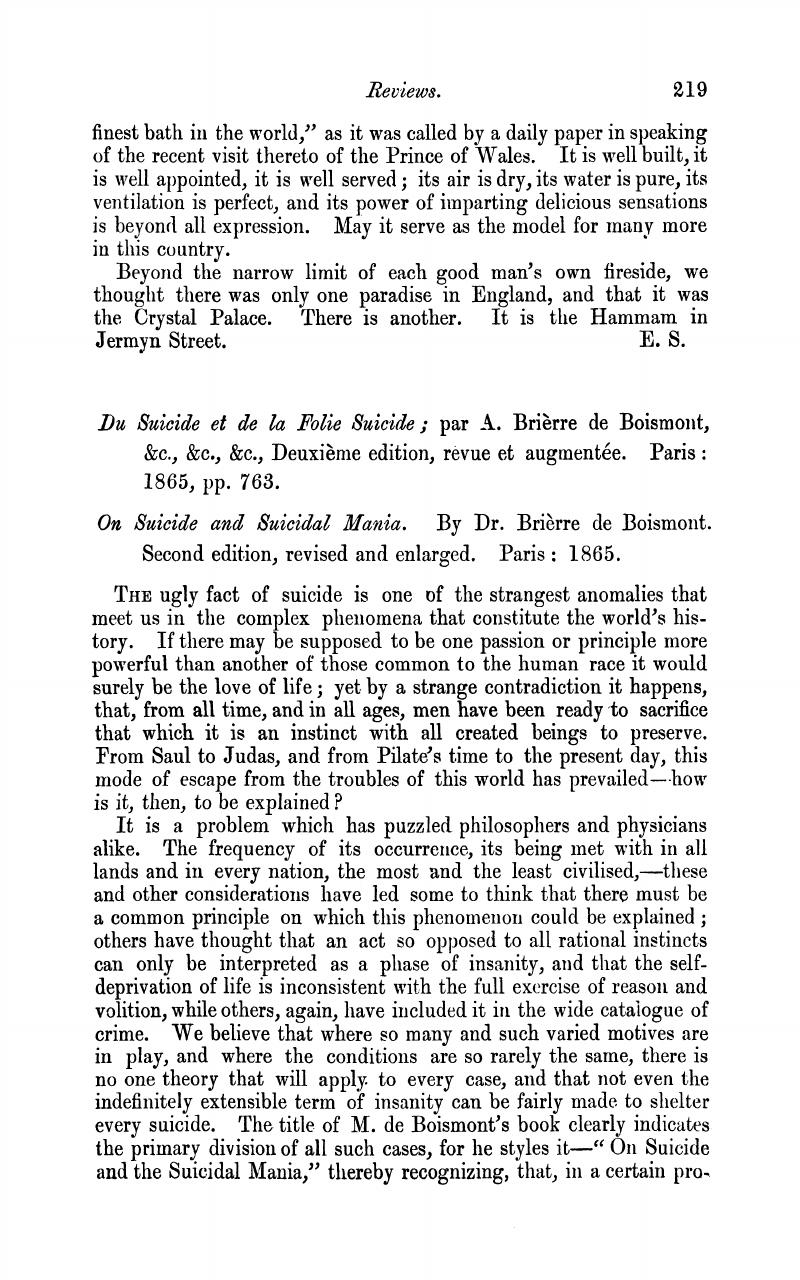No CrossRef data available.
Article contents
Du Suicide et de la Folie Suicide; par A. Brièrre de Boismont, &c., &c., &c., Deuxième edition, revue et augmentée. Paris: 1865, pp. 763. - On Suicide and Suicidal Mania. By Dr. Brièrre de Boismont. Second edition, revised and enlarged. Paris: 1865.
Published online by Cambridge University Press: 19 February 2018
Abstract

- Type
- Part II.-Reviews
- Information
- Copyright
- Copyright © Royal College of Psychiatrists, 1865
References
∗ Tuscul, lib. i, p. 34.Google Scholar
† Winslow's ‘Anatomy of Suicide,’ p. 23.Google Scholar
∗ ‘Journal of the (London) Statistical Society,’ June, 1862, p. 135.Google Scholar
∗ If suicide reigns where “crime is rife,” we ought to expect it as much in the class of old offenders, among those punished for crime, and those who have before them the disagreeable prospect of long imprisonment, if not more than among those living in the pursuit of crime with the pleasing excitement of escaping detection.Google Scholar
According to the ‘Judicial Statistics’ for 1861, there were only six suicides (five men and a woman) in prisons in England and Wales during that year. The number of prisoners at the end of the year was 26,035, but a still larger number must have been admitted in the time.Google Scholar
In one of the best modern English prisons, with a daily average of 215 inmates, there have been six suicides in the last twelve years, and this is more than the proportion for the same period in most county prisons. The particulars of these six cases are as follows, so far as they could be obtained at some distance of time :—1. George G—, æt. 44, called an “incorrigible rogue,” hanged himself, a few minutes after dinner, while awaiting his trial, for no grave offence.Google Scholar
2. George A—, æt. 29, an insolvent debtor, cut his throat with a razor in the night : was much excited on admission, and had been drinking hard just before.Google Scholar
3. William C. A—, æt. 56, hanged himself three weeks after admission.Google Scholar
4. John M—, æt. 34, had been several times in prison, and was sentenced to six years' penal servitude. Hanged himself a month afterwards. The act was supposed to be unpremeditated. He was extravagantly fond of his wife, who was a drunken and bad woman. He had defective palate.Google Scholar
5. William W—, æt. 44, hanged himself while undergoing a nine months' sentence. This was supposed to be an insane act, though he had shown no previous signs of madness. It was found that there was a suicidal mania in the family, the father of deceased having thrown himself down a well, a sister having cut her throat, and another hanged herself.Google Scholar
6. Thomas J—, æt. 16, under a short sentence for theft, hanged himself. This may have been imitative, as it occurred on the same day as the previous instance, and almost at the time of the excitement caused by the act. The boy was said to have been depressed ever since an attack of ague, lasting thirteen weeks in the previous year, and he had also had ague while in prison.Google Scholar
Cases 2, 5, and 6 were clearly pure instances of disease of the brain, of which suicide was a symptom, and most probably No. 4 also. Further investigation would very likely interpret the other two cases in the same way. Crime played quite a secondary part in these deaths, for they would not have occurred without the morbid condition of the brain, plus the hereditary tendencies.Google Scholar





eLetters
No eLetters have been published for this article.